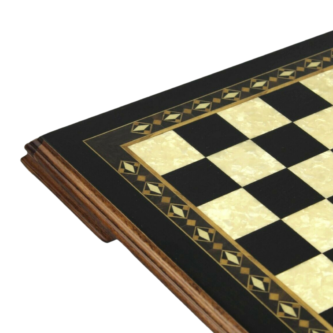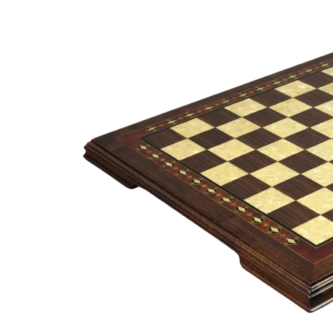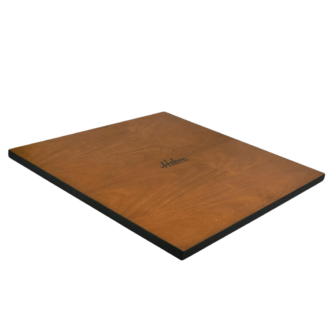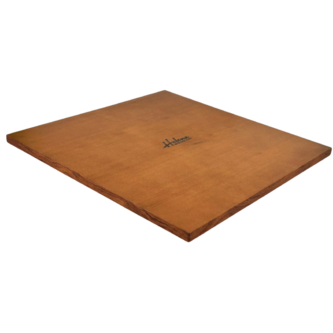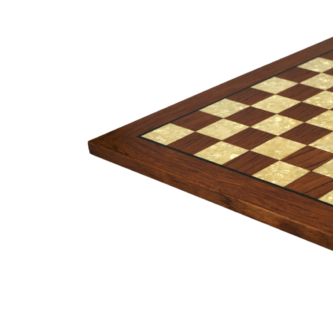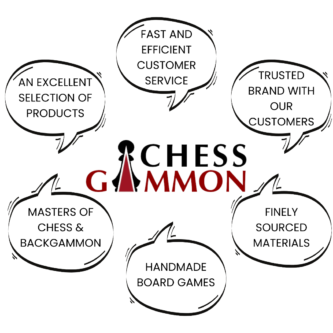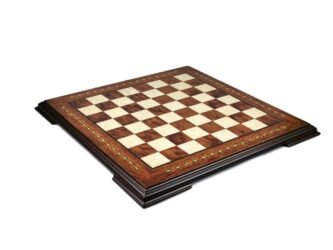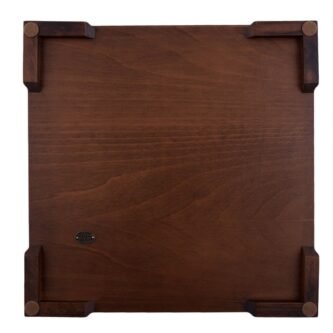Premium Range Chess Board
Wooden Chess Board
Chess, a game that has stood the test of time, transcends boundaries and cultures, captivating minds across the globe with its intricate strategies and intellectual challenges. At the heart of this ancient game lies the chessboard, the sacred arena where battles of wit and cunning take place. Among the various chessboards that have graced the world, the wooden chess board emerges as a timeless classic, epitomizing the essence of chess and captivating enthusiasts for generations.
The Significance of Chess and the Role of the Chessboard:
Chess, often referred to as the “game of kings,” has a rich history that dates back over a millennium. It is a game that demands sharp intellect, foresight, and strategic acumen. Throughout the centuries, chess has been a symbol of intellect and nobility, engaging players from all walks of life, from aristocrats to commoners. As chess is played on a two-dimensional battlefield, the chessboard plays a pivotal role in shaping the game’s dynamics.
The chessboard serves as the canvas upon which the chess pieces move and interact. Its checkerboard pattern of alternating dark and light squares symbolizes the harmony and balance between opposing forces. Each move on the wooden chess board carries the weight of history, as countless generations have honed their skills and fought epic battles on these very squares.
Introduction to the Wooden Chess Board as a Timeless Classic:
Among the myriad materials used to craft chessboards, wood stands out as the most iconic and cherished. Wooden chess boards have graced the world since the game’s inception, exuding a timeless elegance that endures to this day. Handcrafted by skilled artisans with an eye for detail, wooden chess boards bear witness to the artistry and craftsmanship of centuries gone by.
The warm touch and natural texture of the wooden chess board offer a tactile experience unlike any other. Each piece glides smoothly across its polished surface, heightening the connection between player and game. Wooden chess boards, often made from fine woods like mahogany, walnut, or rosewood, evoke a sense of sophistication and refinement, making them more than just gaming accessories but true works of art.
Conclusion:
As we venture into the enchanting world of chess, we find the wooden chess board as an indomitable symbol of tradition and culture. Its role in facilitating the strategic dance of the chess pieces and the elegance it brings to the game are unparalleled. In the chapters that follow, we will delve deeper into the allure of the wooden chess board, exploring its craftsmanship, the best woods used, and why it remains the choice of true chess enthusiasts seeking to partake in the age-old dance of kings on its mesmerizing surface.
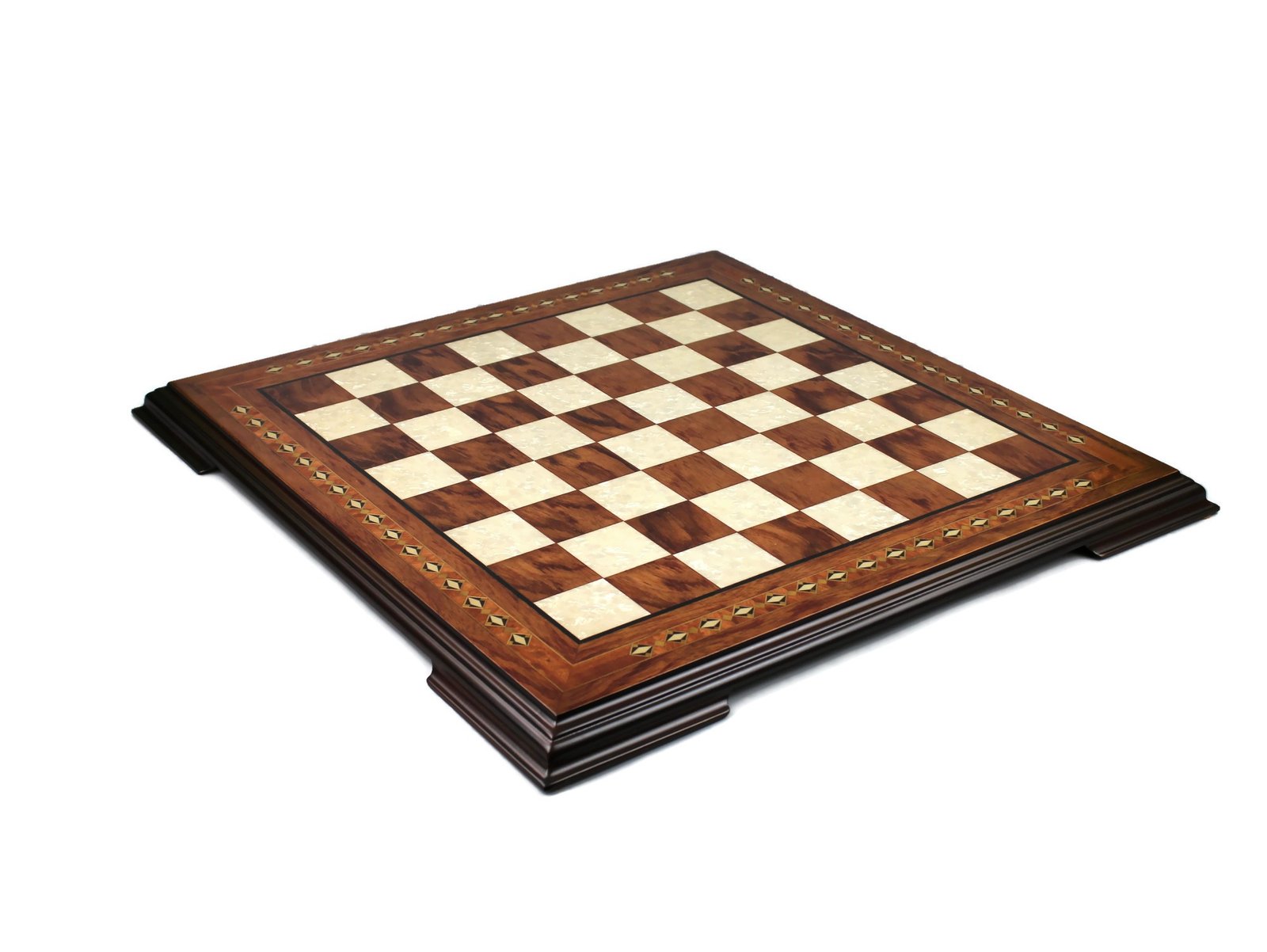
Why are Wooden Chess Boards So Expensive?
Craftsmanship and the Art of Creating Wooden Chess Boards:
The allure of the wooden chess board lies not only in its functionality but also in the intricate craftsmanship that goes into its creation. Crafting a wooden chess board is an art form that demands skill, patience, and attention to detail. Expert artisans, often carrying on age-old traditions, meticulously handcraft each wooden chess board, transforming raw wood into a masterpiece fit for royalty.
Every step of the process requires precision. From selecting the finest wood to cutting, shaping, and assembling the individual squares, artisans pour their expertise into every stroke of the chisel and every layer of varnish. Each wooden chess board is a labor of love, a testament to the dedication and passion of the craftsmen who ensure that every piece aligns perfectly, and the surface remains smooth and inviting to the touch.
Premium-Quality Wood and Its Contribution to the Cost:
The choice of wood plays a significant role in determining the price of a wooden chess board. Premium-quality woods, sourced from sustainable forests or rare exotic varieties, command a higher price due to their scarcity and distinct characteristics. Woods like rosewood, ebony, and boxwood, known for their exceptional beauty and durability, are often favoured by discerning chess enthusiasts and collectors.
In addition to the cost of the raw materials, the process of obtaining and preparing premium-quality wood is both time-consuming and meticulous. Artisans carefully inspect and handpick the wood to ensure it meets their exacting standards, adding to the overall expense of crafting a wooden chess board.
The Unique Allure and Value for True Chess Connoisseurs:
For true chess connoisseurs, the appeal of a wooden chess board extends beyond its utilitarian purpose. It represents a connection to the rich history and traditions of the game. Wooden chess boards have witnessed countless games played by masters and novices alike, carrying within them the weight of time and the stories of victories and defeats.
Owning a wooden chess board is akin to possessing a piece of art—a tangible expression of the player’s love for the game. The uniqueness of each wooden chess board, with its distinctive wood grain and individual character, adds to its allure. Collectors often seek rare and limited-edition wooden chess boards, making them not just a game accessory but also an investment.
What is the Best Wood for a Wooden Chess Board?
Overview of Commonly Used Woods (Mahogany, Walnut, Maple, Rosewood):
When it comes to crafting a wooden chess board, several types of wood have been favoured for their unique qualities and aesthetic appeal. Among the most commonly used woods are mahogany, walnut, maple, and rosewood. Each wood type brings its own character to the chessboard, making the selection process an exciting journey for both artisans and chess enthusiasts.
Characteristics and Aesthetics of Each Wood Type:
- Mahogany:
Mahogany is renowned for its deep reddish-brown hue and elegant appearance. Its fine grain patterns and smooth texture give the wooden chess board a touch of sophistication. Mahogany exudes warmth and richness, making it a popular choice for those seeking a classic and traditional look for their chessboard. - Walnut:
Walnut boasts a darker and more robust appearance compared to mahogany. Its natural dark brown colour with occasional streaks of lighter tones creates a sense of depth and character. The strong, straight grain of walnut wood adds an air of sophistication and complements various interior styles, making it a favoured choice for both traditional and contemporary settings. - Maple:
Maple offers a lighter and more subtle tone, providing a stark contrast to the dark pieces on the wooden chess board. Its fine, even texture and creamy-white colour make for an elegant and understated look. The simplicity of maple allows the chess pieces to take centre stage, making it an excellent choice for those who prefer a clean and minimalistic appearance. - Rosewood:
Rosewood is renowned for its rich reddish-brown colour and striking grain patterns, adding an air of opulence to the wooden chess board. The deep, lustrous hues of rosewood create a captivating visual experience, making it a popular choice for collectors and enthusiasts who seek a luxurious and eye-catching chessboard.
Factors Influencing Wood Choice for a Wooden Chess Board:
The selection of wood for a wooden chess board is influenced by various factors, including:
Aesthetic Preference: Chess enthusiasts may choose a wood type based on their personal taste and the ambiance they wish to create in their playing space.
Budget: Different wood types come with varying price points, and budget considerations may influence the final choice.
Availability: Some exotic wood types may be harder to find or more limited in supply, affecting their availability for crafting chessboards.
Sustainability: Environmentally conscious players may opt for sustainably sourced woods to ensure minimal impact on the environment.
Craftsmanship: The expertise of the artisan and their familiarity with certain wood types may also play a role in the selection process.
What is the Best Size Wooden Chess Board for Home?
Standard Size for Home Chess Boards (2-2.25 Inches Squares):
The standard size for a wooden chess board at home is typically designed with squares measuring 2-2.25 inches. This size has become a popular choice among chess enthusiasts and is widely used in both casual play and formal competitions. The 2-2.25-inch squares strike a perfect balance between ease of play and portability, making them ideal for home setups and on-the-go chess games.
The standard size is not arbitrary; it is the same size used in most tournament-grade chess boards, allowing players to practice and get accustomed to the dimensions they may encounter in official matches. Moreover, it ensures that the pieces have enough space to move comfortably without feeling crowded.
Considering Available Space and Personal Preference:
While the standard size serves as a reliable choice, the best size for a wooden chess board at home may depend on the available space and the player’s personal preference. Some players may have limited space, and a larger chessboard might not fit comfortably. In such cases, a slightly smaller chess board with squares measuring around 2 inches could be a suitable alternative.
On the other hand, players who have ample space and enjoy a more immersive experience may opt for larger wooden chess boards. Chessboards with squares measuring 2.5 to 3 inches can create a grand and imposing presence, adding a touch of majesty to the playing area.
Larger Options for a More Imposing Presence:
A larger wooden chess board not only enhances the aesthetics but also offers a unique experience during the game. The larger squares provide more room for the pieces to move, making it easier to manoeuvre and reducing the chances of accidental piece collisions. Additionally, a bigger chess board can be an impressive centrepiece in a living room or study, becoming a conversation starter and adding a regal touch to the ambiance.
While larger chessboards have their allure, it’s essential to consider that they might require more space and could be less portable. Players need to find the right balance between the visual impact and the practicality of the chess board for their home setup.
How Do You Make a Homemade Wooden Chess Board?

The Joy of Creating a Wooden Chess Board at Home:
Crafting a homemade wooden chess board is not only a rewarding project but also an opportunity to add a personal touch to your chess-playing experience. The process of bringing raw materials to life and creating a chess board with your hands is a gratifying journey for chess enthusiasts and woodworking aficionados alike. Building a homemade wooden chess board allows you to showcase your creativity and passion for the game, resulting in a cherished piece of art that holds sentimental value.
Choosing Contrasting Woods for Squares:
The key to creating an eye-catching homemade wooden chess board lies in selecting contrasting woods for the squares. Traditionally, chessboards feature dark and light squares in an alternating pattern, creating the iconic checkerboard appearance. Popular choices include using darker woods like walnut or ebony for the dark squares and lighter woods such as maple or boxwood for the light squares.
The contrast between the two wood types enhances the visual appeal of the chessboard, making it easier to distinguish the squares and giving the board a touch of elegance. Additionally, the choice of wood can influence the overall ambiance of the chessboard, allowing you to create a classic, contemporary, or unique look that reflects your style and taste.
Step-by-Step Guide to Building a Homemade Wooden Chess Board:
Materials and Tools: Gather the necessary materials, including the contrasting wood types, wood glue, a saw, sandpaper, and a finish such as varnish or lacquer.
Cutting the Wood: Start by cutting the wood into equal-sized squares. For the standard chessboard size with 2.25-inch squares, you’ll need 32 dark squares and 32 light squares.
Assembling the Squares: Arrange the squares in an alternating pattern, ensuring that the dark and light squares form the iconic checkerboard layout. Use wood glue to attach the squares firmly together.
Sanding the Surface: Once the glue has dried, sand the surface of the chessboard to achieve a smooth finish. Pay attention to the edges and corners to ensure they are free of splinters and sharp edges.
Applying a Finish: To protect the wood and enhance its natural beauty, apply a finish of your choice, such as varnish or lacquer. The finish adds a protective layer and highlights the wood’s grain patterns, giving the homemade chessboard a polished and professional appearance.
Final Touches: After the finish has dried, inspect the homemade wooden chess board for any imperfections and make any necessary touch-ups. Your chessboard is now ready for hours of exciting gameplay.
What Wooden Chess Board Do Professionals Use?
Importance of Precision and Attention to Detail for Professionals:
For professional chess players, every element of their playing environment matters, and the choice of a wooden chess board is no exception. Precision and attention to detail are crucial factors that professionals seek in their chess boards. A high-quality wooden chess board ensures consistent square sizes and perfectly aligned squares, enabling smooth and accurate movement of the pieces. Professionals rely on these well-crafted boards to enhance their focus during intense matches and to eliminate any distractions that could affect their performance.
Tournament-Grade Wooden Chess Boards and Adherence to FIDE Standards:
In official chess tournaments, the chessboard used must meet specific standards set by the International Chess Federation (FIDE). These tournament-grade wooden chess boards adhere to precise specifications, ensuring a level playing field for all competitors. The FIDE regulations dictate the size of squares, height and width of borders, and the overall dimensions of the chessboard. By using tournament-grade wooden chess boards, professionals can practice on the same type of board they will encounter in official competitions, providing them with a familiar and consistent playing experience.
Renowned Manufacturers and Their Offerings for Professional Players:
Several renowned manufacturers specialize in crafting high-quality wooden chess boards designed for professional play. These manufacturers have honed their expertise over the years, producing chess boards that meet the exacting standards required by professionals. Many of these chess boards are made from premium hardwoods and boast exquisite craftsmanship, ensuring both durability and aesthetic appeal.
Some of the well-regarded manufacturers offer a range of designs and styles to cater to different preferences. Professionals can choose from various wood types, finishes, and sizes to find the perfect wooden chess board that complements their playing style and personal taste.
Which Colour is Best for a Wooden Chess Board?

Classic Black and White for Tournaments and Its Benefits:
The classic combination of black and white squares on a wooden chess board has been the standard choice for tournaments and competitive play for many years. This timeless colour scheme offers several benefits that make it the preferred option for official matches. The high contrast between the dark and light squares enhances visibility, making it easier for players and spectators to distinguish between the pieces and follow the game’s progress.
Moreover, the black and white design adds a touch of formality and tradition to the chessboard, creating a sense of seriousness and professionalism in tournament settings. Players are accustomed to this standard layout, allowing them to focus on the game without any unnecessary distractions.
Personal Preference and Unique Colour Combinations:
While the classic black and white is the traditional choice, the best colour for a wooden chess board is ultimately a matter of personal preference. Some chess enthusiasts prefer to explore more unique colour combinations, deviating from the conventional look to create a chessboard that reflects their individual style.
For instance, brown and beige squares can provide a warm and inviting atmosphere, while blue and ivory squares can evoke a sense of tranquillity and elegance. By selecting colours that resonate with their personal taste, players can imbue the chessboard with a distinct personality and make their chess-playing experience even more enjoyable.
Impact of Colours on the Overall Ambiance of the Wooden Chess Board:
Colours play a significant role in setting the ambiance of the chessboard’s playing environment. Darker colours, like deep mahogany or ebony for the dark squares, can create a sense of gravity and sophistication, while lighter colours, such as maple or boxwood for the light squares, can lend an air of openness and brightness to the chessboard.
The choice of colours can also complement the surrounding décor and style of the room where the chessboard is placed. A chessboard with colours that harmonize with the overall interior design can become an elegant centrepiece, adding both functionality and aesthetic appeal to the space.
Conclusion:
Recapitulation of the Allure of the Wooden Chess Board:
Throughout history, the wooden chess board has stood as a timeless classic, enchanting players and collectors with its beauty and elegance. Crafted with precision and attention to detail, each wooden chess board is a masterpiece that embodies the artistry of skilled artisans. The allure of wooden chess boards lies not only in their functionality but also in the sentimental value they hold. Whether it’s the rich reddish-brown hues of mahogany, the boldness of walnut, the subtlety of maple, or the opulence of rosewood, each wood type brings its charm, making every chessboard unique and captivating.
The Enduring Appeal for Chess Enthusiasts Worldwide:
Chess, the game of kings, has transcended centuries and continues to captivate minds worldwide. In the heart of this intellectual pursuit, the wooden chess board remains an integral part, serving as the sacred stage where strategic battles unfold. Its enduring appeal lies in the connection it fosters between players and the game—a tactile and visual experience that adds depth and intimacy to the chess-playing journey. From casual players to professionals, the wooden chess board continues to be the cherished choice, symbolizing the shared passion for chess across cultures and generations.
Final Thoughts on the Significance of the Wooden Chess Board in the Game of Chess:
The wooden chess board is more than a mere playing surface; it is a symbol of tradition, craftsmanship, and artistry. Each move made on its surface carries the weight of history, echoing the countless games played by masters and novices throughout time. The wooden chess board’s significance extends beyond aesthetics and practicality—it embodies the essence of chess itself, encapsulating the battle of minds, the pursuit of strategic brilliance, and the spirit of competition.
As players gather around the wooden chess board, they enter a realm where centuries of tradition meet modern-day challenges. From the classic black and white squares of tournaments to the personalized colour combinations that reflect individual tastes, the wooden chess board offers a canvas for self-expression and a gateway to an immersive chess experience.
In conclusion, the wooden chess board’s allure, enduring appeal, and significance in the game of chess are a testament to the enduring power of this ancient pastime. As the pieces move across its carefully crafted surface, players become part of a timeless tradition—a dance of kings and queens on a stage that will continue to inspire, challenge, and captivate generations of chess enthusiasts for ages to come.



